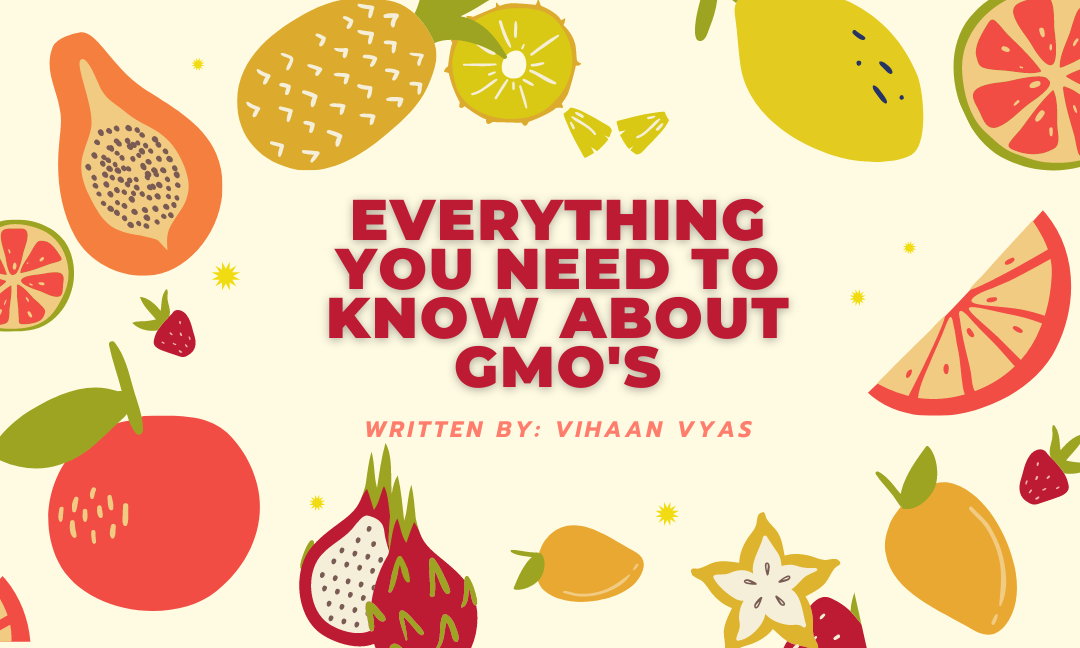Written by Vihaan Vyas
Edited by Kiritika Rana
Designed by Alessa Zaitseva
Published by Kiritika Rana
Genetically Modified Organisms (GMOs) have been a hot topic in the food industry for decades. From health concerns to environmental impacts, the debate surrounding GMOs is complex and often contentious. This blog post aims to provide an overview of GMOs, addressing their benefits, risks, and controversies.
What Are GMOs?
Genetically Modified Organisms (GMOs) are organisms whose genetic material has been artificially manipulated through genetic engineering. This technology allows for introducing new traits or characteristics that do not occur naturally through traditional crossbreeding methods. GMOs are widely used in agriculture to create crops resistant to pests, diseases, and environmental conditions, as well as to improve crop yields and nutritional content.
The History of GMOs
The history of GMOs dates back to the early 20th century when scientists first began to understand the principles of genetics. However, the first genetically modified plant, a tobacco plant resistant to antibiotics, was not created until 1983. The first commercially available GMO crop, the Flavr Savr tomato, was introduced in 1994. Since then, the use of GMOs has expanded rapidly, with genetically modified crops now making up a significant portion of the world’s food supply.
Benefits of GMOs
- Increased Agricultural Productivity: GMOs are engineered to increase crop yields and reduce the need for chemical inputs such as pesticides and herbicides. For example, Bt corn, which produces a natural insecticide, has significantly reduced the need for chemical insecticides.
- Enhanced Nutritional Content: Genetic engineering has been used to enhance the nutritional content of certain crops. Golden Rice, for example, has been modified to contain higher levels of Vitamin A, which can help combat vitamin A deficiency in developing countries.
- Environmental Sustainability: GMOs can contribute to environmental sustainability by reducing the need for chemical inputs, conserving soil, and reducing greenhouse gas emissions. For instance, herbicide-tolerant crops enable the use of no-till farming practices, which can help preserve soil structure and reduce erosion.
Risks and Controversies
- Health Concerns: One of the primary concerns surrounding GMOs is their potential impact on human health. Critics argue that GMOs may cause allergic reactions or have long-term health effects that are not yet understood. However, numerous scientific studies have concluded that GMOs are safe for human consumption. The National Academy of Sciences, the World Health Organization, and many other reputable organizations have stated that GMOs pose no more risk to human health than conventional crops.
- Environmental Impact: While GMOs can have environmental benefits, there are also potential risks. The widespread use of herbicide-tolerant crops, for example, has led to an increase in herbicide use, which can have negative impacts on biodiversity and lead to the development of herbicide-resistant weeds. Additionally, the impact of GMOs on non-target organisms and ecosystems is still not fully understood.
- Economic and Social Issues: The commercialization of GMOs is often controlled by a few large corporations, which raises concerns about market monopolies and the economic impact on small farmers. There are also ethical concerns related to patenting genetically modified seeds and the potential loss of biodiversity. Regulation and Labeling The regulation of GMOs varies significantly around the world. In the United States, the Food and Drug Administration (FDA), the Environmental Protection Agency (EPA), and the Department of Agriculture (USDA) share responsibility for regulating GMOs. These agencies have determined that GMOs are safe and do not require special labelling. However, public pressure has led to the introduction of non-GMO labels and the passing of state-level labelling laws in some states. In contrast, the European Union has adopted a more cautious approach, with strict regulations and mandatory labelling for all GMO products. This reflects a more precautionary stance and a higher level of public skepticism towards GMOs in Europe.
- The Future of GMOs: The future of GMOs is likely to be shaped by advances in genetic engineering technology, such as CRISPR-Cas9, which allows for more precise and targeted genetic modifications. These advances could lead to the development of new GMO crops with enhanced traits, such as improved drought tolerance or resistance to a wider range of pests and diseases. Additionally, as the global population continues to grow, GMOs may play an increasingly important role in ensuring food security. However, the future of GMOs will also depend on public acceptance, regulatory frameworks, and ongoing scientific research to address potential risks and concerns.
Conclusion
GMOs are a powerful tool with the potential to address some of the world’s most pressing agricultural and nutritional challenges. While they offer significant benefits, they also pose certain risks and have sparked considerable debate. Understanding the science behind GMOs, their benefits, and their risks is crucial for making informed decisions about their use and regulation. As technology advances and our knowledge of GMOs continues to grow, it is essential to balance innovation with caution to ensure a sustainable and secure food future.
References
National Academy of Sciences Report on GMOs
World Health Organization: Frequently Asked Questions on GMOs
Environmental Protection Agency: Regulation of Biotechnology for Use in Pest Management
Food and Drug Administration: GMO Plants

